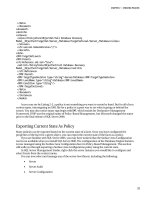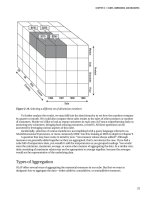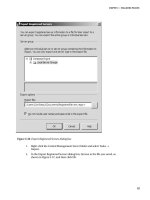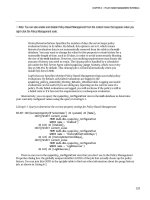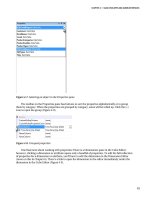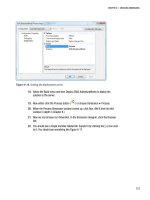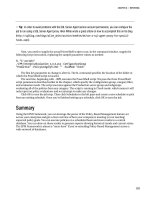1319 pro SQL server 2008 analysis services
Bạn đang xem bản rút gọn của tài liệu. Xem và tải ngay bản đầy đủ của tài liệu tại đây (15.06 MB, 468 trang )
CYAN
MAGENTA
YELLOW
BLACK
PANTONE 123 C
BOOKS FOR PROFESSIONALS BY PROFESSIONALS ®
THE EXPERT’S VOICE ® IN SQL SERVER
Companion
eBook Available
Dear Reader,
SQL Server Analysis Services (SSAS) is a powerful online analytical processing (OLAP)
and data-mining environment included with Microsoft’s database platform. Pro SQL
Server 2008 Analysis Services is your guide to using Analysis Services along with SQL
Server to deliver effective business intelligence (BI) solutions. We show how to create
data source views, build and deploy a cube for analysis, and mine your data for business insight, and ultimately for profit.
Our desire is to pave your path to success by sharing our experience. We show
how SQL Server professionals use SSAS to address and solve real-world challenges
every day. We discuss SSAS features in detail, including the enhanced Cube and
Dimension Designers. For administrators, we discuss several areas in server management. These include cube processing and processing options, the Performance
Monitor, scheduling, and security.
Business intelligence solutions require metrics. To deliver metrics to your users,
you will learn how to define, create, and use key performance indicators (KPIs), calculated members, perspectives, and actions. Data mining with SSAS enables you
to create predictions based on trends in historical data stores of virtually any size.
SQL Server Analysis Services and Microsoft Office 2010 are now tightly integrated to enable self-service business intelligence capabilities across the enterprise.
PowerPivot is a new set of technologies that give end users the tools needed to perform complex analysis and data mining at their workspace. We introduce you to
PowerPivot, helping you get started with this new and important tool.
We believe you will gain valuable experience with SQL Server Analysis Services,
as well as insights into developing BI solutions, by applying the methods demonstrated throughout this book.
Companion eBook
Philo Janus & Guy Fouché
THE APRESS ROADMAP
See last page for details
on $10 eBook version
Beginning
SQL Server 2008
for Developers
Accelerated
SQL Server 2008
Pro
SQL Server 2008
Analysis Services
Pro SQL Server
2008 Analytics
Pro
SQL Server 2008
Reporting Services
www.apress.com
US $44.99
ISBN 978-1-4302-1995-8
5 44 9 9
Janus
Fouché
SOURCE CODE ONLINE
Release 2!
Pro
SQL Server 2008 Analysis Services
Pro SQL Server 2008 Analysis
Services
Covers
Pro
SQL Server 2008
Analysis Services
Create value and competitive advantage through
careful mining and analysis of your company’s
business data
Philo Janus and Guy Fouché
Shelve in:
Database / SQL Server
User level:
Intermediate–Advanced
9 781430 219958
www.it-ebooks.info
this print for content only—size & color not accurate
7.5 x 9.25 spine = 0.90625" 480 page count
Pro SQL Server 2008
Analysis Services
Philo Janus
Guy Fouché
www.it-ebooks.info
Pro SQL Server 2008 Analysis Services
Copyright © 2010 by Philo Janus and Guy Fouché
All rights reserved. No part of this work may be reproduced or transmitted in any form or by any means,
electronic or mechanical, including photocopying, recording, or by any information storage or retrieval
system, without the prior written permission of the copyright owner and the publisher.
ISBN-13 (pbk): 978-1-4302-1995-8
ISBN-13 (electronic): 978-1-4302-1996-5
Printed and bound in the United States of America 9 8 7 6 5 4 3 2 1
Trademarked names, logos, and images may appear in this book. Rather than use a trademark symbol with
every occurrence of a trademarked name, logo, or image we use the names, logos, and images only in an
editorial fashion and to the benefit of the trademark owner, with no intention of infringement of the
trademark.
The use in this publication of trade names, trademarks, service marks, and similar terms, even if they are not
identified as such, is not to be taken as an expression of opinion as to whether or not they are subject to
proprietary rights.
Publisher and President: Paul Manning
Lead Editor: Jonathan Gennick
Technical Reviewers: Dana Hoffman and Fabio Claudio Ferrachiatti
Editorial Board: Clay Andres, Steve Anglin, Mark Beckner, Ewan Buckingham, Gary Cornell, Jonathan
Gennick, Jonathan Hassell, Michelle Lowman, Matthew Moodie, Duncan Parkes, Jeffrey Pepper,
Frank Pohlmann, Douglas Pundick, Ben Renow-Clarke, Dominic Shakeshaft, Matt Wade, Tom
Welsh
Coordinating Editors: Candace English and Fran Parnell
Copy Editors: Sharon Wilkey and Mary Ann Fugate
Compositor: Bytheway Publishing Services
Indexer: John Collin
Artist: April Milne
Cover Designer: Anna Ishchenko
Distributed to the book trade worldwide by Springer Science+Business Media, LLC., 233 Spring Street, 6th
Floor, New York, NY 10013. Phone 1-800-SPRINGER, fax (201) 348-4505, e-mail , or visit www.springeronline.com.
For information on translations, please e-mail , or visit www.apress.com.
Apress and friends of ED books may be purchased in bulk for academic, corporate, or promotional use.
eBook versions and licenses are also available for most titles. For more information, reference our Special
Bulk Sales–eBook Licensing web page at www.apress.com/info/bulksales.
The information in this book is distributed on an “as is” basis, without warranty. Although every precaution
has been taken in the preparation of this work, neither the author(s) nor Apress shall have any liability to
any person or entity with respect to any loss or damage caused or alleged to be caused directly or indirectly
by the information contained in this work.
The source code for this book is available to readers at www.apress.com. You will need to answer questions
pertaining to this book in order to successfully download the code.
www.it-ebooks.info
CONTENTS
Contents at a Glance
Contents.................................................................................................................. v
About the Authors................................................................................................ xiv
About the Technical Reviewers ............................................................................ xv
Acknowledgments ............................................................................................... xvi
Introduction ........................................................................................................ xvii
Chapter 1: Introduction to OLAP .............................................................................1
Chapter 2: Cubes, Dimensions, and Measures .....................................................15
Chapter 3: SQL Server Analysis Services..............................................................41
Chapter 4: SSAS Developer and Admin Interfaces...............................................75
Chapter 5: Creating a Data Source View...............................................................97
Chapter 6: Creating Dimensions .........................................................................117
Chapter 7: Building a Cube .................................................................................167
Chapter 8: Deploying and Processing.................................................................195
Chapter 9: MDX...................................................................................................219
Chapter 10: Cube Features .................................................................................251
Chapter 11: Data Mining .....................................................................................275
Chapter 12: PowerPivot ......................................................................................311
Chapter 13: Administration.................................................................................333
Chapter 14: User Interfaces ................................................................................373
Appendix A: Setting Up Adventure Works...........................................................431
Appendix B: Data-Mining Resources ..................................................................435
Index ...................................................................................................................437
iv
www.it-ebooks.info
CONTENTS
Contents
Contents at a Glance.............................................................................................. iv
Contents.................................................................................................................. v
About the Authors................................................................................................ xiv
About the Technical Reviewers ............................................................................ xv
Acknowledgments ............................................................................................... xvi
Introduction ........................................................................................................ xvii
Chapter 1: Introduction to OLAP .............................................................................1
From Pivot Tables to Dimensional Processing...................................................................2
Data Warehousing .............................................................................................................4
Applications of OLAP..........................................................................................................5
History of OLAP ..................................................................................................................7
SQL Server Analysis Services ............................................................................................8
Data Mining .....................................................................................................................13
Summary .........................................................................................................................14
Chapter 2: Cubes, Dimensions, and Measures .....................................................15
Cubes and Their Components..........................................................................................15
Defining Measures and Dimensions ................................................................................18
Schemas................................................................................................................................................. 18
Dimensions in Depth............................................................................................................................... 20
Measures................................................................................................................................................ 27
Types of Aggregation.............................................................................................................................. 31
v
www.it-ebooks.info
CONTENTS
Writeback ............................................................................................................................................... 32
Calculated Measures .............................................................................................................................. 33
Actions.............................................................................................................................34
XMLA................................................................................................................................35
Multidimensional Expressions (MDX) ..............................................................................36
Data Warehouses.............................................................................................................37
Storage ............................................................................................................................38
Staging Databases.................................................................................................................................. 38
Storage Modes ....................................................................................................................................... 38
Summary .........................................................................................................................39
Chapter 3: SQL Server Analysis Services..............................................................41
Requirements ..................................................................................................................41
Hardware................................................................................................................................................ 41
Virtualization........................................................................................................................................... 43
Software ................................................................................................................................................. 44
Upgrading ............................................................................................................................................... 44
Standard or Enterprise Edition?.............................................................................................................. 44
Architecture .....................................................................................................................46
The Unified Dimensional Model .............................................................................................................. 46
Logical Architecture................................................................................................................................ 49
Physical Architecture.............................................................................................................................. 52
Storage ................................................................................................................................................... 54
Cube Structures in SSAS .................................................................................................59
Data Sources .......................................................................................................................................... 61
Data Source View ................................................................................................................................... 61
The Cube Structure Itself........................................................................................................................ 63
Dimensions............................................................................................................................................. 64
Mining Structures ................................................................................................................................... 65
vi
www.it-ebooks.info
CONTENTS
What’s New in SQL Server 2008......................................................................................65
Performance ........................................................................................................................................... 65
Tools ....................................................................................................................................................... 69
Summary .........................................................................................................................73
Chapter 4: SSAS Developer and Admin Interfaces...............................................75
Business Intelligence Development Studio......................................................................75
BIDS Is Visual Studio? ............................................................................................................................ 75
Panes...................................................................................................................................................... 76
Solution Explorer .................................................................................................................................... 79
Properties Pane ...................................................................................................................................... 80
Creating or Editing a Database Solution................................................................................................. 82
SQL Server Management Studio......................................................................................86
Managing Analysis Services................................................................................................................... 87
Executing MDX Queries .......................................................................................................................... 91
PowerShell.......................................................................................................................92
A Convincing Example ............................................................................................................................ 93
PowerShell for SQL Server ..................................................................................................................... 93
PowerShell with SSAS............................................................................................................................ 94
Summary .........................................................................................................................95
Chapter 5: Creating a Data Source View...............................................................97
Cubes Need Data .............................................................................................................97
Data Sources ...................................................................................................................98
Data Source Views.........................................................................................................105
Designer Tour ....................................................................................................................................... 105
Named Calculations and Queries.......................................................................................................... 110
Summary .......................................................................................................................116
vii
www.it-ebooks.info
CONTENTS
Chapter 6: Creating Dimensions .........................................................................117
Dimensional Analysis.....................................................................................................117
Review of the Dimension Concept........................................................................................................ 118
Star or Snowflake? ............................................................................................................................... 119
Dimensions in SSAS ......................................................................................................127
Creating a Dimension ........................................................................................................................... 127
Analysis Management Objects (AMO) Warnings................................................................................... 135
Dimension Properties ........................................................................................................................... 136
Attributes .......................................................................................................................148
Attribute Relationships ......................................................................................................................... 150
Attribute Properties .............................................................................................................................. 156
Parent-Child Dimensions ...............................................................................................157
The Time Dimension ......................................................................................................159
Summary .......................................................................................................................166
Chapter 7: Building a Cube .................................................................................167
Dimensions and Cubes ..................................................................................................169
Creating Cubes ..................................................................................................................................... 170
Using Measure Group Tables................................................................................................................ 170
Selecting Dimensions ........................................................................................................................... 173
Defining Dimension Usage ................................................................................................................... 179
Measures and Measure Groups.....................................................................................182
Measures.............................................................................................................................................. 182
Measure Groups ................................................................................................................................... 184
Calculated Measures ............................................................................................................................ 185
Summary .......................................................................................................................193
Chapter 8: Deploying and Processing.................................................................195
Deploying a Project........................................................................................................195
Project Properties ................................................................................................................................. 195
viii
www.it-ebooks.info
CONTENTS
Deployment Methods............................................................................................................................ 198
Using the Deployment Wizard........................................................................................198
Running the Wizard .............................................................................................................................. 199
Input Files ............................................................................................................................................. 201
Deployment Scripts .............................................................................................................................. 202
Synchronizing SSAS Databases.....................................................................................202
Processing .....................................................................................................................204
What Processing Does for Us ............................................................................................................... 205
How to Initiate Processing from BIDS................................................................................................... 208
Processing from SQL Server Management Studio................................................................................ 214
Processing via XMLA ............................................................................................................................ 215
Processing with Analysis Management Objects (AMO) ........................................................................ 215
Scheduling OLAP Maintenance......................................................................................215
Summary .......................................................................................................................218
Chapter 9: MDX...................................................................................................219
Why the Need?...............................................................................................................219
Tuples and Sets .............................................................................................................221
Notation ................................................................................................................................................ 222
Tuples ................................................................................................................................................... 223
Sets ...................................................................................................................................................... 228
MDX Queries ..................................................................................................................228
SELECT ................................................................................................................................................. 229
WHERE.................................................................................................................................................. 232
MDX Functions...................................................................................................................................... 233
Categories of Functions........................................................................................................................ 239
Summary .......................................................................................................................249
Chapter 10: Cube Features .................................................................................251
Business Intelligence.....................................................................................................251
ix
www.it-ebooks.info
CONTENTS
Time Intelligence .................................................................................................................................. 252
Account Intelligence ............................................................................................................................. 254
Dimension Intelligence ......................................................................................................................... 255
Operators, Functions, and More ....................................................................................255
Unary Operators.................................................................................................................................... 255
Custom Member Formulas ................................................................................................................... 256
Attribute Ordering................................................................................................................................. 257
Currency Conversion ............................................................................................................................ 257
Calculations Tab ............................................................................................................258
Calculated Measures ............................................................................................................................ 259
Named Sets .......................................................................................................................................... 262
Other Cube Features......................................................................................................262
Key Performance Indicators ................................................................................................................. 263
Actions.................................................................................................................................................. 265
Perspectives ......................................................................................................................................... 270
Translations .......................................................................................................................................... 272
Summary .......................................................................................................................273
Chapter 11: Data Mining .....................................................................................275
Why Mine Data?.............................................................................................................275
Using Data-Mining Algorithms.......................................................................................276
Microsoft Naïve Bayes.......................................................................................................................... 276
Microsoft Clustering ............................................................................................................................. 276
Microsoft Decision Trees ...................................................................................................................... 277
Creating the Accessory Buyers Marketing Campaign....................................................277
Preparing the Data Warehouse......................................................................................278
Creating the Accessory Buyers Views in AdventureWorks................................................................... 278
Creating the Accessory Campaign Data Source View .......................................................................... 281
Finding Accessory Buyers by Using the AdventureWorks EDW .....................................282
x
www.it-ebooks.info
CONTENTS
Using the Data Mining Model Designer .........................................................................289
The Mining Structure View ................................................................................................................... 290
The Mining Models View ...................................................................................................................... 291
The Mining Model Viewer View ............................................................................................................ 292
The Mining Accuracy Chart View.......................................................................................................... 297
The Mining Model Prediction View ....................................................................................................... 299
Finding Accessory Buyers by Using Data Mining Extensions (DMX)..............................303
Use the DMX Development Environment .............................................................................................. 303
Create the Accessory Buyers Mining Structure.................................................................................... 304
Add a Naïve Bayes Mining Model to the Accessory Buyers Campaign................................................. 305
Process the Accessory Buyers Campaign ............................................................................................ 305
View the Accessory Buyers Mining Model............................................................................................ 306
Predict Our Accessory Buyers .............................................................................................................. 308
Summary .......................................................................................................................310
Chapter 12: PowerPivot ......................................................................................311
PowerPivot Support in SQL Server 2008 R2 ..................................................................311
Master Data Services ........................................................................................................................... 311
Excel Writeback.................................................................................................................................... 313
PowerPivot from Excel...................................................................................................320
PowerPivot with SharePoint Server 2010......................................................................326
Summary .......................................................................................................................331
Chapter 13: Administration.................................................................................333
DBA Tasks......................................................................................................................333
Processing a Cube................................................................................................................................ 333
Processing Options............................................................................................................................... 335
Processing Architecture ....................................................................................................................... 336
Profiler.................................................................................................................................................. 337
Performance Monitor............................................................................................................................ 337
xi
www.it-ebooks.info
CONTENTS
Automation ........................................................................................................................................... 339
XML for Analysis................................................................................................................................... 340
Analysis Management Objects ............................................................................................................. 340
PowerShell ........................................................................................................................................... 343
Scheduling............................................................................................................................................ 343
SQL Server Integration Services........................................................................................................... 345
Security..........................................................................................................................348
Authentication ...................................................................................................................................... 348
Authorization ........................................................................................................................................ 349
Performance ..................................................................................................................352
Design................................................................................................................................................... 352
Aggregations ........................................................................................................................................ 359
Scaling.................................................................................................................................................. 367
Virtualization......................................................................................................................................... 369
SharePoint Server 2010........................................................................................................................ 369
Summary .......................................................................................................................371
Chapter 14: User Interfaces ................................................................................373
Excel 2007 .....................................................................................................................373
Data Source Connections ..................................................................................................................... 374
Pivot Tables .......................................................................................................................................... 379
Pivot Charts .......................................................................................................................................... 386
Visio 2007 ......................................................................................................................399
SQL Server Reporting Services......................................................................................401
Reports ................................................................................................................................................. 401
Tablix .................................................................................................................................................... 402
Charts ................................................................................................................................................... 410
Report Builder 2.0................................................................................................................................. 418
MOSS 2007 ....................................................................................................................420
xii
www.it-ebooks.info
CONTENTS
KPI Lists................................................................................................................................................ 421
Excel Services ...................................................................................................................................... 423
PerformancePoint ..........................................................................................................423
Appendix A: Setting Up Adventure Works...........................................................431
Appendix B: Data-Mining Resources ..................................................................435
Index ...................................................................................................................437
xiii
www.it-ebooks.info
About the Authors
Philo Janus is a senior technology specialist with Microsoft. Over the years he has presented
Microsoft Office InfoPath to thousands of users and developers, and assisted with enterprise
implementations of InfoPath solutions. With that background, he is particularly sensitive to the
difficulties users and developers have had with InfoPath.
He graduated from the US Naval Academy with a bachelor of science in electrical engineering in
1989 to face a challenging career in the US Navy. After driving an aircraft carrier around the Pacific
Ocean and a guided-missile frigate through both the Suez and Panama Canals, and serving in the US
Embassy in Cairo, a small altercation between his bicycle and an auto indicated a change of career
(some would say that landing on his head in that accident would explain many things).
Philo’s software development career started with building a training and budgeting application in
Access 2.0 in 1995. Since then he’s worked with Oracle, Visual Basic, SQL Server, and .NET, building
applications for federal agencies, commercial firms, and conglomerates. In 2003 he joined Microsoft as a
technology specialist, evangelizing Office as a development platform.
Guy Fouché is a business intelligence and decision support system
consultant in the Dallas, Texas area. Guy spends his evenings playing
one of his eight trumpets and expanding his composition skills by
using the current generation of music technologies. On the weekend,
he puts as many miles as he can on his bright yellow Honda F4i sport
motorcycle. Guy and his wife Jodi enjoy taking nine-day trips in their
Jeep 4×4, taking photographs and writing travelogs along the way.
You can view their photography at .
xiv
www.it-ebooks.info
About the Technical Reviewers
Fabio Claudio Ferrachiatti is a senior consultant and a senior analyst/developer of Microsoft
technologies. He works for Brain Force at its Italian branch (www.brainforce.it). He is a Microsoft
Certified Solution Developer for .NET, a Microsoft Certified Application Developer for .NET, and a
Microsoft Certified Professional, as well as a prolific author and technical reviewer. Over the past ten
years, he’s written articles for Italian and international magazines and coauthored more than ten books
on a variety of computer topics.
Born in Brooklyn, New York, Dana L. Hoffman often jokes that her name should have been Data. She
has always had a sharp eye for detail and an avid desire to create systems that are not just workable, but
intuitive and easy to use. She always tries to see things from the user’s point of view, and sees technical
reviewing as an excellent opportunity to put her nitpicking skills to good use. With a background in
programming and database development, Dana currently works as a data analyst. She lives in
Connecticut and is nearly finished raising two sons.
xv
www.it-ebooks.info
INTRODUCTION
Acknowledgments
I’d like to offer a huge thank-you to everyone at Apress who has had input into these pages!
Guy Fouché
xvi
www.it-ebooks.info
Introduction
Pro SQL Server 2008 Analysis Services offers an in-depth look into the latest and greatest suite of analytic
tools from Microsoft. This book will help you create business intelligence (BI) solutions that improve
your company’s analysis and decision making by focusing on practical, solution-oriented application of
the technologies available in SQL Server 2008 Analysis Services (SSAS).
Using the examples and exercises in this book, you will further your understanding of online
analytical processing (OLAP), BI, data mining, and SSAS itself. New SSAS features are also explained,
including the Management Data Warehouse (MDW), dynamic management views (DMVs), and
Aggregation Designer. Improvements to the Cube and Dimension Designers are also covered.
Chapters 1 and 2 introduce you to OLAP, and to the key concepts that are termed cubes, dimensions,
and measures. With that foundation laid, Chapters 3 and 4 introduce you to what SQL Server provides.
You’ll get your first look at Analysis Services and its administration interface. Chapters 5 through 7 show
you how to design and build a cube for analysis. The cube is the focal point of Analysis Services. Once
you’ve created a cube, Chapter 8 shows how to deploy it for use.
After you’ve deployed a cube, it is available for you and other analyists to query. It is partly through
queries that one examines and analyzes the data at one’s disposal. To that end, Chapter 9 is devoted to
Multidimensional Expressions (MDX), which is the query language underpinning Analysis Services
solutions.
Key performance indicators (KPIs) are at the heart of every BI solution. In Chapter 10, you will learn
how to define, create, and use these metrics. Chapter 10 also introduces you to perspectives, actions,
and calculated members.
Data-mining algorithms enable you to sift through huge amounts of historical data, and create
predictions based on trends and patterns. Working through Chapter 11, you will learn how to use data
mining to create, execute, and validate a prediction model. Chapter 11 will also introduce you to
Microsoft’s Data Mining Extensions (DMX) language.
PowerPivot is an exciting set of technologies that provide powerful BI abilities to all business users.
By integrating with Office 2010, your users can perform complex analysis and data mining on their
workstations. Using SSAS language translation and automated currency conversions greatly enhances
the usability of your company’s data across the enterprise.
Finally, Chapter 13 offers important information for SSAS administrators. To effectively manage
SSAS at the server level, you need to understand processing tasks and options, the SQL Server Profiler,
the Performance Monitor, scheduling, and security.
xvii
www.it-ebooks.info
CHAPTER 1
Introduction to OLAP
Online analytical processing (OLAP) is a technique for aggregating data to enable business users to dig
into transactional data to solve business problems. You may be familiar with pivot tables from Microsoft
Excel or other reporting solutions—for example, taking a list of order details (Figure 1-1) and creating a
table that shows the total for each product ordered by month (Figure 1-2).
Figure 1-1. Tabular order data
1
www.it-ebooks.info
CHAPTER 1 INTRODUCTION TO OLAP
Figure 1-2. Summarizing products by month ordered
This is an interesting report, but what if we want to see the breakdown by quarter? Or by year? Or by
fiscal year? Perhaps we want to combine the products into groups—for example, if we don’t care so
much how a specific product is faring, but we do want to know how our condiments are selling overall.
We might be able to create some of these reports from existing data, or we might be able to write a query
to do so. Some will require modifications to the database.
However, we have another problem: in this database, we have only 2,155 order details and 77
products—a pretty easy group of data to deal with. What do we do when we have 500 products (or
more—consider Amazon.com!) and tens of thousands of records? What about millions? We can’t expect
Microsoft Excel to create pivot tables from all those records for us. To solve this problem of analyzing
large amounts of data, we turn to a server-based solution that can take large amounts of tabular data and
create these aggregations for us.
From Pivot Tables to Dimensional Processing
Take another look at Figure 1-2, order totals of products by month ordered. We have two dimensions to
our data: product and month. This is a pretty basic pivot table based on a tabular data source. Now let’s
say we want to see this same table, but broken down for each geographic region (Figure 1-3).
2
www.it-ebooks.info
CHAPTER 1 INTRODUCTION TO OLAP
Figure 1-3. Breaking down orders by geographic region
Now we have a third dimension: geographic region. Consider arranging the data as shown in Figure
1-4.
Figure 1-4. Understanding multidimensional data
3
www.it-ebooks.info
CHAPTER 1 INTRODUCTION TO OLAP
With three dimensions to the data, we have a cube. We will be using that term a lot. Of course, we
don’t have to stop with three dimensions. We can break the orders down by customer, by discount level,
by product type, and so on. As you start to consider the exponential impact of having multiple
dimensions, with each dimension having dozens of members, you will start to appreciate that
presenting a tool to a nontechnical user to deal with this type of analysis is a nontrivial problem.
Looking at Figure 1-4, what does it look like when we want to also break it down by warehouse
location and shipping method? And yes, we still call it a cube when there are more than three
dimensions.
Let’s take a step back and look at another problem we can face when aggregating data. Let’s take our
order data and create a pivot table to show products ordered by customer (Figure 1-5).
Figure 1-5. Products ordered by customer
Obviously, few customers would order every product, so we see there is a lot of empty space. This is
referred to as a sparse data set. The problem we have is that we are taking up space for every
combination of customer and product, and these empty cells add up pretty quickly. OLAP servers are
designed to optimize for storage of sparse data sets and aggregations.
Data Warehousing
A term that you’ll frequently encounter in analytic processing—and that is horribly overused—is data
warehouse. You may also hear data mart. (I will confess to also occasionally using model when I’m more
interested in presenting the business problem we’re trying to solve than getting into a debate about
semantics.) Although these terms are not completely synonymous, they are often used interchangeably.
Data warehouse is easily the scariest word on the list. As this book will show you, working with OLAP
technologies is relatively straightforward. I don’t mean to trivialize the work necessary to build a robust
dimensional solution, but the difficulty can be overhyped. A data warehouse is, most basically, a
compilation of data fundamental to the business that has been integrated from numerous other sources.
For example, you can pull salary data from an HR system, vendor data from an ERP system, customer
4
www.it-ebooks.info
CHAPTER 1 INTRODUCTION TO OLAP
billing information from a financial system, and create a financial data warehouse for the company (to
start calculating profits and losses, profit margins, and so forth).
A data warehouse does not need to be dimensional. You could create a normalized relational
database for querying and reporting. However, you will find it difficult to create many of the types of
reports users expect from a very large storage of data (users and analysts will generally focus on
aggregation and large-scale analysis as opposed to basic tabular reports).
Because data warehouse generally implies large-scale and cross-corporate information, people may
perceive, as I mentioned, that data warehouses are heavy engineering efforts requiring a great deal of big
up-front design. Where possible, I prefer to grow these types of resources organically: start with small
projects, solve individual business problems, and grow the resulting data marts as necessary, finally
bridging over to create an actual data warehouse if and when it is deemed necessary. I am very much
about iterative design, and the work in this book supports that approach in design and maintenance of
OLAP solutions.
Applications of OLAP
Multidimensional analysis of large quantities of data has applications in every line of business, as well as
scientific analysis and research. Following are some examples:
•
An executive might use a front-end analysis tool against corporate data to
identify overall trends or causal relationships in corporate performance. In
addition, aggregated data enables creation of corporate scorecards to provide
“at a glance” views of how the business is doing (Figure 1-6).
Figure 1-6. A corporate scorecard built on OLAP data
5
www.it-ebooks.info
CHAPTER 1 INTRODUCTION TO OLAP
•
A sales manager would find sales reports combining the transactional data
we’ve been discussing (Figure 1-7) useful. These reports can show how
products have been selling and can easily be configured to break down the
data in a sensible way. Also, using a special OLAP query language, reports can
be built to “roll” forward as time goes on—for example, a report may show
just the last three quarters. Instead of having to write a complex query or
constantly update the report, a simple statement such as
[Dimensions].[Time].[FiscalQuarter].PrevMember would always show the
last full quarter of data.
Figure 1-7. A report produced from OLAP data
•
A business user will prefer using a desktop tool such as Excel to perform ad
hoc analysis of data (Figure 1-8). Excel, ProClarity, and other tools like these
provide the ability to dig through data, produce reports, and perform analysis
on large amounts of information from numerous data sources that have been
aggregated, scrubbed, and normalized.
6
www.it-ebooks.info
CHAPTER 1 INTRODUCTION TO OLAP
Figure 1-8. Using Excel to analyze OLAP data
Now that you have a rough feel of what OLAP is and why we’re interested in it, let’s take a look at
where OLAP came from.
History of OLAP
Multidimensional analysis dates back to the 1960s and IBM’s implementation of APL for managing
large-scale arrays. However, although APL was very important, the requirement of a mainframe to run it
on and its arcane language (including Greek letters) kept it firmly in a small niche. APL continues to run
applications to this day, but when is the last time you encountered anyone discussing it?
In the 1970s, the next step in OLAP evolution came forth in an actual application: Express. Express
was designed to provide data-aggregation services and eventually became Express Server. Express was a
command-line-based application, and data was managed with scripts. Express Server was acquired by
Oracle in 1996, and the OLAP technologies were folded into Oracle9i.
E.F. Codd (father of the relational database) coined the term OLAP in 1993. Although other products
performed large-scale data aggregation before that, Codd’s creation of the term formed a foundation for
technologies to grow on. Around the same time, Arbor Software (which merged with Hyperion Software
in 1998) released their OLAP product, Essbase (originally eSSbase). Essbase was a client-server product
that presented a (proprietary) spreadsheet as the front end, and ran a PC-based server application on the
back end.
7
www.it-ebooks.info
CHAPTER 1 INTRODUCTION TO OLAP
A number of OLAP vendors followed through the 1990s, but by the close of the 20th century,
Microsoft would change the game twice. First, although other vendors were the first to consider using a
spreadsheet application as a front end for OLAP, Microsoft’s Excel was the first platform that truly
became a ubiquitous analysis front end and had the extensibility hooks enabling other vendors to
leverage it for their own use. By 2004, most OLAP vendors leveraged Excel as a user-friendly front end.
Microsoft’s second game-changer was to enter the OLAP server market themselves.
SQL Server Analysis Services
In 1996, Microsoft acquired OLAP technology from Panorama Software. It shipped with SQL Server 7 as
OLAP Services (www.microsoft.com/technet/prodtechnol/sql/70/maintain/olap.mspx). OLAP Services
offered a Cube Creation Wizard to design cube schemas, a Microsoft Management Console (MMC)
snap-in to manage the services, and Pivot Table Services for client-side OLAP. In SQL Server 2000, the
feature was renamed SQL Server Analysis Services (SSAS).
OLAP capabilities were underappreciated in SQL Server 7 and 2000. Between the perception that
SQL Server wasn’t ready for larger database tasks, and the lack of an easy way of viewing the output of
the aggregations, it pretty much sailed under the radar. (SQL Server 2000 had a community solution that
allowed viewing cube info, but having to download and compile a viewer for an enterprise data solution
can make one wonder.) Another drawback to SSAS 2000 was that the underlying relational data had to
already be in a star schema, which you mapped the cube onto. This made a staging database
(intermediate data storage) almost mandatory.
SQL Server 2005 really brought Analysis Services into the spotlight. The cube designer was united
with Integration Services and Reporting Services in the Business Intelligence Development Studio, or
BIDS (Figure 1-9), and Analysis Services was accessible via the unified environment of SQL Server
Management Studio (Figure 1-10).
Figure 1-9. The New Project Wizard in BIDS
8
www.it-ebooks.info
